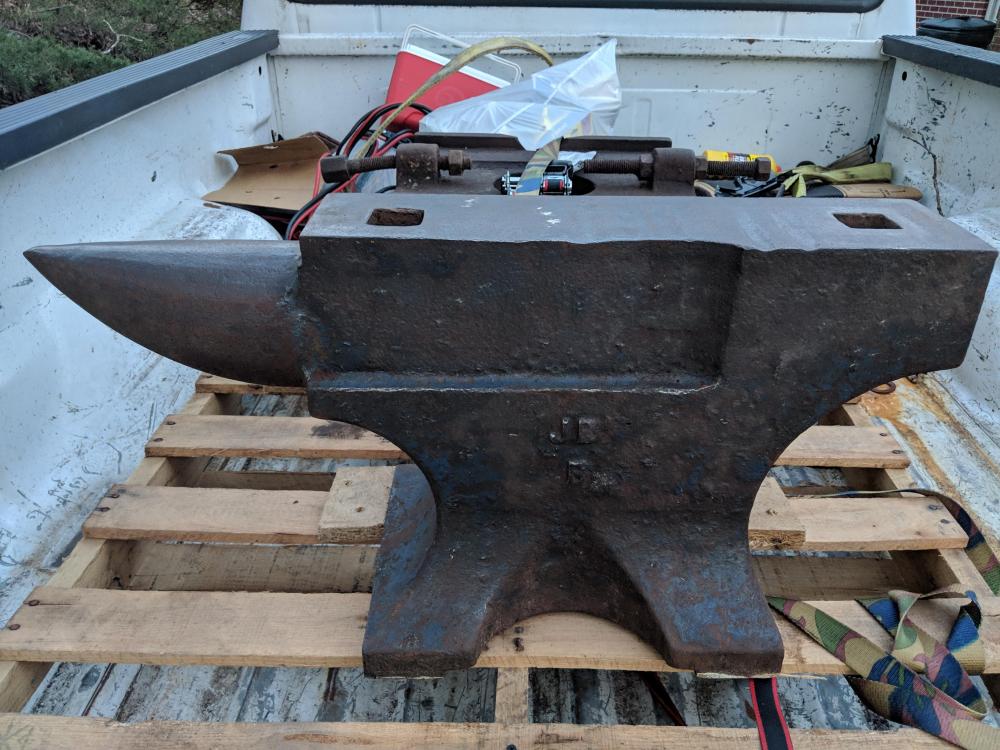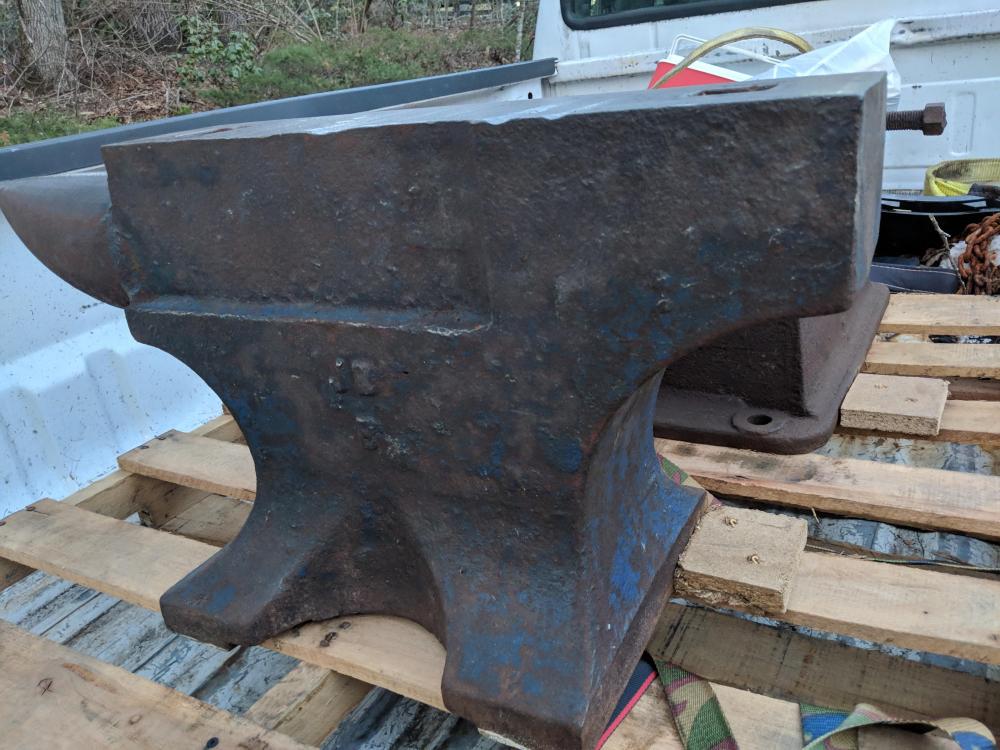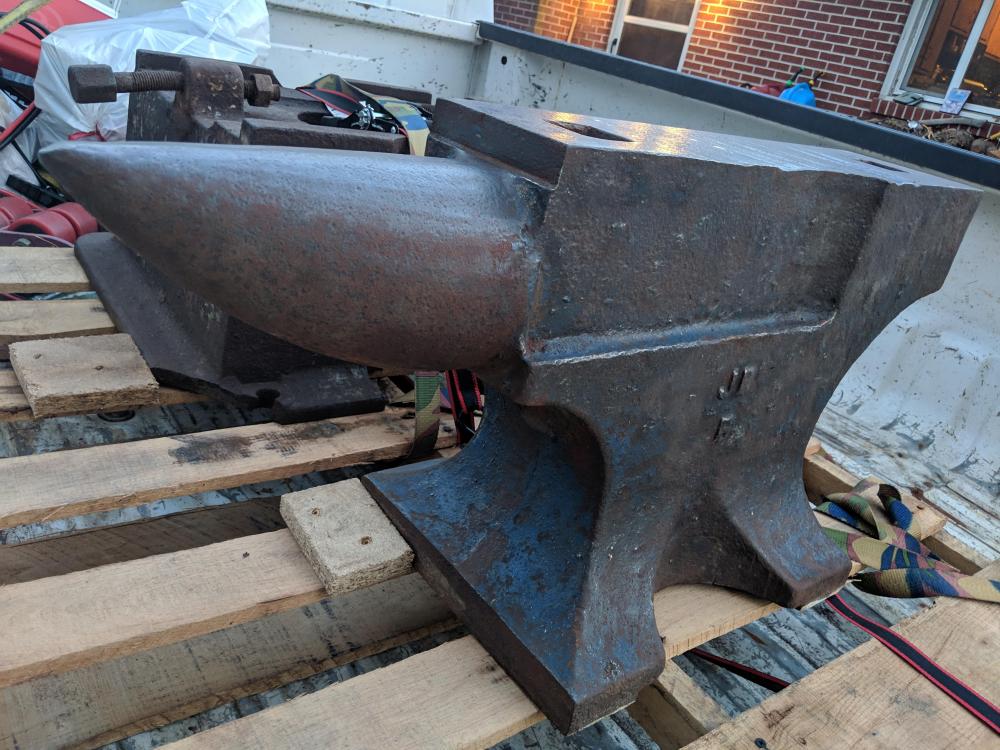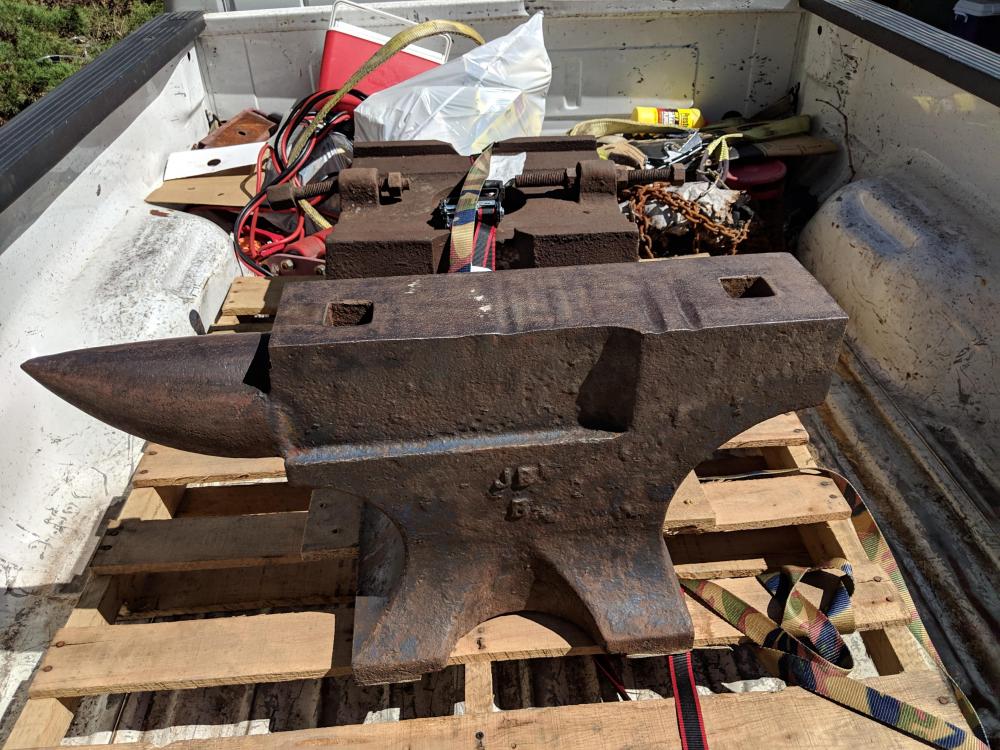
Bob Brandl
Members-
Posts
80 -
Joined
-
Last visited
Content Type
Profiles
Forums
Articles
Gallery
Downloads
Events
Everything posted by Bob Brandl
-
Looks pretty solid. Well done. I generally do a thicker core vs outside bars when doing any kind of cladding or whatever, but didn't see this post before now. Sorry about that. You'll be fine for sure, but it helps to have the extra mass for the core of the billet. That's how I look at it, anyway. It has a lot more to do with what steels you're using than anything. I've done several stainless "san mai" blades, and with the stainless you have to account for it wanting to move less under a hammer at temp vs. your high carbon core, so you can get away with thinner stainless and a thicker core than you would think. With similar steels that move about the same, though, the thicker parts will have thinned out less than the thinner parts, so that's what you have "more" of when you're done with forging. As far as a ratio, I always go with a 2:1 ratio core to cladding, and flip it if I'm more concerned about the cladding than the core. That said, I don't do a ton of precision forging when it comes to patterning, so take all this with a grain of salt...or three.
-
Re-softening a clay tempered blade
Bob Brandl replied to Olorin's topic in Heat Treating Knives, Blades etc
Railroad clips fall in the dead mid-grade carbon content to the low end of high, so water works alright, but oil is generally better. It's not as hard on the steel. Go buy a few liters of canola oil. And like we had talked about before, free steel is great, but it's always preferable to work with a known alloy if you're making a tool out of it. -
Re-softening a clay tempered blade
Bob Brandl replied to Olorin's topic in Heat Treating Knives, Blades etc
As an addition to the three pins, you might also think about this: depending on the alloy you're using, as well as what you're quenching in, you have a small window after the initial quench to straighten the blade while it's "hardening." No, that's not at all the technical term, but I'm trying to keep this relatively simple. And by small window, I mean something in the order of 6-10 seconds, if you're Super lucky and careful. I usually leave a blade in the quench for a 6 count, check for straightness, and if it's warped I'll stick in a vise, or if I haven't gotten rid of them again, I'll put it between sections of angle iron (I like aluminum for it, but steel works quite well) and clamp it somehow. I've also just lightly hammered it straight on a stump or other block of wood, but I don't recommend that unless you're feeling froggy...still don't do it. The angle works better on longer blades, but it's effective regardless. It's a little sketchy and takes a lot of practice to get down, but I've yet to crack a blade, let alone break one doing it that way. Using the pins during a temper cycle is less sketchy, but doing it the way I described gives you a little more plasticity with regard to the metal. Ideally, conditions would be ideal enough for warping to not be a problem in the first place, but that isn't the case as often as anyone would like, and most would admit. I don't do a whole lot of differential hardening, but it shouldn't make a ton of difference doing it that way with something knife to big knife sized. At least I don't think so. -
I wouldn't fool with it.
-
bed frame knives
Bob Brandl replied to Jaegers Forge and Foundry's topic in Knife making Class General Class Discussion
I've heard of people using steel from heavy duty and older bed frames for all kinds of tools and such, but having never done it myself, I can't attest to it one way or another. Don't know that I'd fool with it, even if it were. You do you, though, haha. -
No worries at all. Always glad to help.
-
Check out Burt Foster's how to videos. He's about the best bladesmith around, and has the teaching background necessary to Actually teach people some things. Jason Knight also has videos on YouTube that are very informative, and he's crazy good, too.
-
I'm inclined to wonder the same thing with regard to the forge atmosphere. I've been using kerosene for a while when I make damascus, and have had no problems with it. Hmm...
-
Little Giant 50lb or Blu Max 110lb
Bob Brandl replied to cdnaxe's topic in Power Hammers, Treadle Hammers, Olivers
If you take the tooling out of the picture, the Little Giant is a better hammer for general work within certain parameters, and I personally never liked working tooling under any Blu I've ever run. I've run several different iterations of the Blu, and it not only seems to me like they get more complicated with each version, but there's also the issue of the air compressor, and that they choke at the drop of a hat. Honestly, if I were going to use tooling at all, I'd hunt for almost any 100lb+ mechanical. But, it's not my money, haha. Either one will be fun and work.- 21 replies
-
- mechanical hammer
- air hammer
-
(and 2 more)
Tagged with:
-
Little Giant 50lb or Blu Max 110lb
Bob Brandl replied to cdnaxe's topic in Power Hammers, Treadle Hammers, Olivers
Little Giant, definitely. Using tooling on either one is kind of a pain, in my opinion, but given the choice I'd definitely go with the Little Giant.- 21 replies
-
- mechanical hammer
- air hammer
-
(and 2 more)
Tagged with:
-
150lb Peter Wright, face is mangled
Bob Brandl replied to CtG's topic in Anvils, Swage Blocks, and Mandrels
Yup, they're right. That's a fixer upper for sure. But, it ought to be worth the work and all to get it back into shape. -
That's definitely not a bad price for it. it's a fuzz higher than what I paid for mine, but I bought mine a good while back, and this one is in a little better shape than mine was. John Brooks anvils have become my anvil of choice over the years, and I have (and have had) more than a few. I'd buy it, especially given that it looks to be in pretty good shape.
-
You know what makes me want to slap people? People whining and fussing about what other people decide to do with their tools, and stating opinion as gospel truth. I'll grant that whoever worked on that anvil does appear to have wrecked it, but that was their decision and they have to live with it. I've done more than a few repairs on anvils and other blacksmithing tools, and more than a few of those times I've used a mill or grinder. Should someone work with mills, grinders, or other cutting/grinding/welding tools without knowing what they're doing and the particulars of what they're working on? No, of course not. But if someone knows what they're doing, or knows someone who does, it's a perfectly valid way to fix something/clean something up, as is welding up an anvil face or corners if necessary. It's a shame about that anvil, but it's not your problem to deal with, it's theirs.
-
Stainless San Mai questions
Bob Brandl replied to fleur de lis's topic in Knife making Class General Class Discussion
I second the welding of the seams, as well as the drill rod in the pipe and all the prep. you can do on the steels. I've had an air pocket form on me with the welded seam before from getting in a hurry and not getting as flat a grind on everything as I should have, but I lucked out and managed to power through it. Mostly because the bubble was isolated to the very end of the billet, though. Anymore I mostly leave a little bit of the seam exposed on one end and soak in WD-40 or kerosene (I prefer kerosene) before I weld. Works like a charm...most of the time, haha. Also, and I doubt it has anything really to do with the success/fail rate, but I always weld the seams with stainless wire or filler rod now, regardless of the jacket and core steel configuration. I don't seem to have nearly as may issues with delamination as I did using regular wire/rod with the same forging setup. Likely makes no difference, but it works for me. -
New with a Kohlswa Anvil (I think)
Bob Brandl replied to DanJohnson's topic in Anvils, Swage Blocks, and Mandrels
I just had the face on my Brooks milled down, and it was pretty xxxxxx hard at .070" deep, and I figure I could have gone down another .030" or .040" and still been fine, what with it being cast steel. Not saying yours would necessarily be the same, but you look like you would need to take way less off than I needed to on mine. I really like most Swedish made anvils. Almost as much as Brooks', haha! -
Brooks anvil question...
Bob Brandl replied to Bob Brandl's topic in Anvils, Swage Blocks, and Mandrels
Could a mod/admin please remove this thread? Thanks. -
Brooks anvil question...
Bob Brandl replied to Bob Brandl's topic in Anvils, Swage Blocks, and Mandrels
Thanks. So, in these pictures, you can see where a previous owner had gone a little hammer happy with the Blacker, especially with those half on/half off hammer blows. It makes sense why they are there, so I'm not super worried about the anvil being too soft...per se. That's why I asked about heat treating information so I could hazard a guess about how much I could take off. If this were an anvil with a welded on face, this would be a non issue and I wouldn't be seeking advice. The trick is that it's cast steel and I've never had to do anything more than make a few passes with an angle grinder to just clean a cast steel anvil up. I don't want to make a hash of this, and that's why I'm asking. With that, does Anyone know where I could find this information, or mind helping me out if you know? Thanks, all. -
Brooks anvil question...
Bob Brandl replied to Bob Brandl's topic in Anvils, Swage Blocks, and Mandrels
I realize that, but I prefer that it has one. Been using them for right around 12 years (24000 hours, give or take), and a flat face is, and has been, my preference. Not saying it's better, but it suits my work and me best. As to pictures, I'll try and post them here soon. Bad internet and all, haha. -
I just got hold of a Blacker anvil by John Brooks, and it's got some damage to it. I'm currently planning on milling the face down enough to have a mostly flat surface to work off of, but am holding off until I can figure a few things out. Specifically, what sort of steel the thing was cast from (I'd guess something like 1045, but I don't know); and how it would have been heat treated so I could guess the depth of hardening. I only need to take off .125"-.150", so I don't think it would be a huge deal, but thought I'd look into it a little bit before I did anything. Does anyone know about such things? I hope so, haha. Thanks very much for your time!
-
Massive PowerHammer in Scrap Yard?
Bob Brandl replied to Avadon's topic in Power Hammers, Treadle Hammers, Olivers
Must have! -
Beaudry Conversion
Bob Brandl replied to Bryan Absher's topic in Power Hammers, Treadle Hammers, Olivers
Don't do it. -
Hello, all. I'm not looking to buy. Just getting that out there, haha. I'm in the process of Hoping to buy one, so no worries there. What I am looking for, however, is someone that has a 100# or 125# Bradley compact that's pretty well complete, or knows someone with one I could get in touch with that would be willing to let me study it; or possibly get me any information at all. The one I'm maybe buying is in pretty rough shape, so it would be Awesome to have access to one so I could figure out what it needs, measurements, etc. I live in NC, so maybe someone "local" might see this? Anyway, thanks to everyone that sees this, and to anyone that can help!
-
Alright. First of all, for what it's worth and If this is even allowed past the moderators, my removing me post was to a conveniently and Heavily edited response from a moderator (based on the tone, I imagine Mr. Sells) that was Far more scathing, rude, and unwarranted than my initial response could have been. Could I have said sarcastic? Smart aleck? I could have, and for offending someone and violating forum rules, I apologize. I will not, however, apologize for my tone, or having made the post. It was a yes or no question, simple and clean, and nothing was asked for or offered other than my getting derided over not providing as much information as wasn't necessary to answer the initial question. Someone just wanted to show how smart they were, and wanted to use my post as an opportunity to do it. That didn't, and doesn't, fly with me. Period. I want to be taught, learn, and enrich my knowledge in this artistic arena. Truly. What I don't need is to be "taught a lesson" with regards to Anybody trying to "put me in my place" by being insulting and condescending, which is what I felt Mr. Powers was doing, and what Mr. Sells Is doing. If you deciding I'm a former troll is what you're going to do to put me down, go for it. It's not true in the slightest, but I don't particularly care. You want me out of the club, kick me out. Oh, and Spare me the "We should to protect you." nonsense. You're only getting rid of me to stroke an ego, make an example, or whatever self-serving end you're actually meeting. You accused me of acting like a three year old, but have you thought about how you're acting, Mr. Trunchbull? Anyway, it's done. Remove me, keep me, I don't care. Bob Brandl Admin Edit: Personal contact information to Mr. Sells removed. Off site link removed.
-
Then by all means, remove me.
-
To me, heat treating means everything from post forging annealing all the way through to tempering. Annealing is a stage, same as hardening. I honestly don't need anyone, experienced or otherwise, to be kind of a xxxxxxxx or take it upon themselves to teach me a lesson. If I'm asking, logic and deductive reasoning dictates that I'm planning to use it as an anvil, which means that whether I used proper terminology or not (which I did), you know exactly what I'm asking and can hazard an answer to my question. Thank you, all the same. You posed a open question and details were asked for, be aware there are other uses for a 4140 fork tyne than just an anvil, and the heat treating requirements for them are different.



